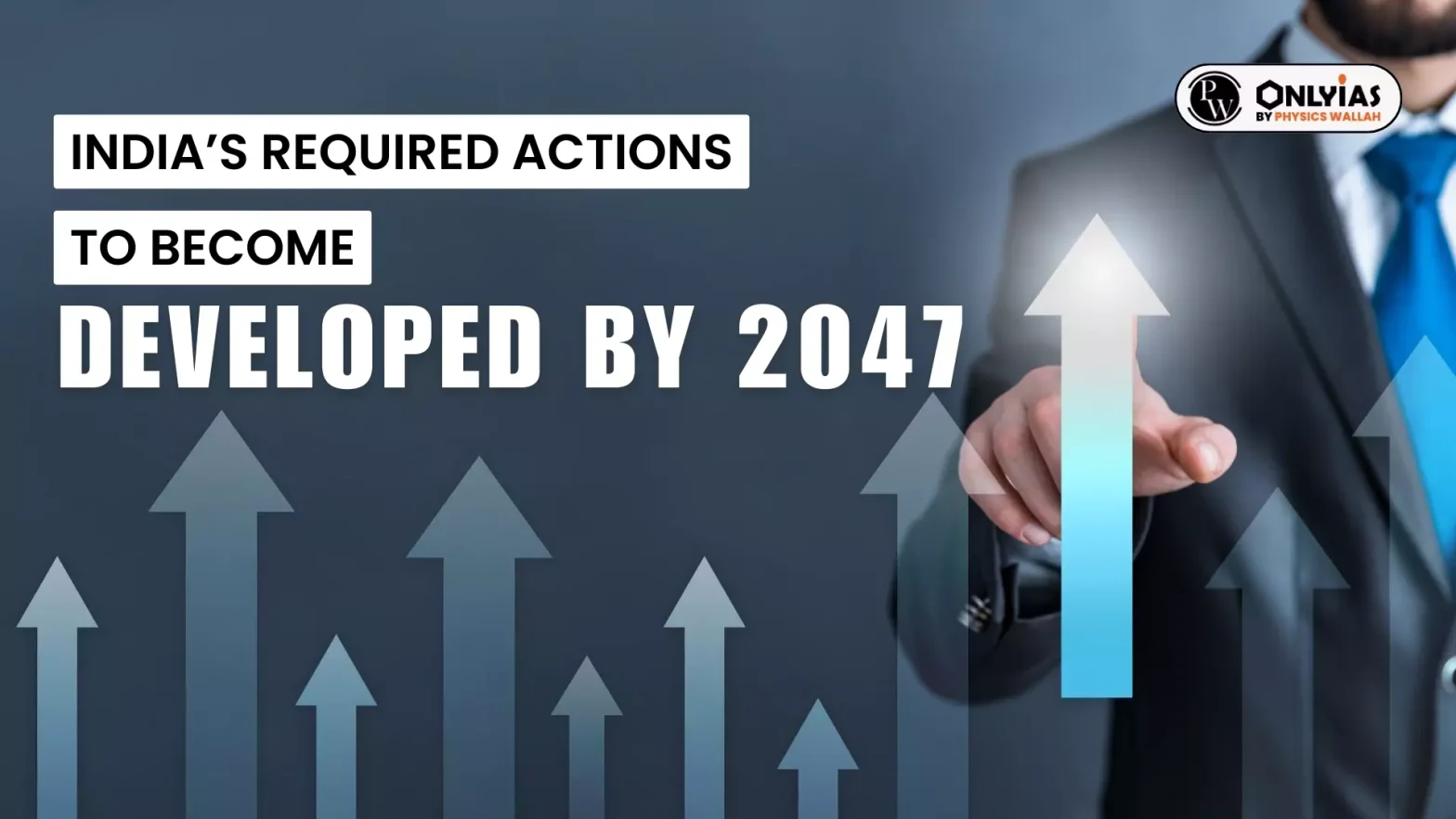This article prospects the challenges faced by India to become a developed country by 2047 and suggests few actions to achieve the desired goal.
| Relevancy for Prelims: World Poverty Clock and Gini Coefficient.
Relevancy for Mains: India to become Developed by 2047- Arising Concerns, and Actions that need to be taken. |
Arising Concerns
- To Attain the Level: International financial organisations currently classify countries with per capita income of $13,845 and above as developed countries.
- India’s per capita income as of now is $2,500 (IMF, April 2024).
- Based on assumptions of the future exchange rate of rupee and domestic inflation, India needs to have an average annual real rate of growth of 6 to 7% to achieve this level of per capita income.
- Rise in Government Capex: The recent increase in the real gross fixed capital formation (GFCF) rate has been largely due to an increase in government capital expenditures, especially of the central government.
- This growth in government capex cannot be sustained because it has been accompanied by a high fiscal deficit of the Centre, which was in the range of 6.7%, 6.4% and 5.9% in the three post-covid years.
Enroll now for UPSC Online Course
Actions That Need To Be Taken
- Investment Attractiveness: There is a need for a pickup in private investment by 1 to 2% points of GDP. To achieve this, India needs to create an environment for private investment, both corporate and non-corporate, to increase.
- Redesigning of Industrial Policy: Experts are suggesting redesigning of industrial policy in light of ongoing global developments.
- After World War II, many East Asian countries adopted an export-led growth strategy and made rapid progress.
- Subsequently, China adopted a similar policy and its share increased in world exports from 0.6% in 1970 to 11.9% 2022.
- In contrast, although India’s share in world exports was also 0.6% in 1970, it only increased to 2.5% by 2022.
- Focus on Exports: Exports are a test of efficiency and India has shown its excellence in the export of services and now there is a need to prove it in terms of merchandise too because external demand is one of the drivers of growth.
- Time for Multi-dimensional Strategy: India needs to emphasize exports, services, manufacturing, agriculture etc. It would be useful to identify “sunrise” industries.
- Example: The food processing industry may be given high priority as it is labour-intensive, helps agriculture and has export demand.
- Need to Follow Efficient Import Substitution: Rather than “import substitution” in all cases, India needs to focus on efficient import substitution. Atmanirbhar should not degenerate into inefficient “import substitution”.
- The Russia-Ukraine war threw up an important issue. Due to supply disruptions caused by the war, many countries started thinking about self-sufficiency for “critical imports”. India also thought about manufacturing chips.
- Creation of Adequate Jobs: The emergence of Artificial Intelligence (AI), Gen AI and machine learning is causing both alarm and excitement. India needs to absorb this new technology, which will require further skill development.
- At the same time, it is required to develop a mix of sectors that will ensure jobs increase along with growth.
- Focus on Equity: The benefits of growth must be distributed equitably. Equity also requires an emphasis on health and education as part of public expenditure in terms both of quantum and quality.
- It is desirable to achieve growth and reduce poverty and inequality. Without growth, equity will be a distant dream and without equity, growth cannot be sustained.
- Achievement by India: There is evidence that the poverty ratio has been coming down. According to the World Poverty Clock, extreme poverty in India measured by a poverty line of $2.15 (2017 PPP) has fallen below the threshold of 3%.
- In fact, in the latest update, it has fallen to 2% of the population, implying that extreme poverty in India has been eliminated.
- A recent consumption expenditure survey for 2022-23 confirms that the computed Gini coefficient, which measures inequality, has also marginally reduced.
Enroll now for UPSC Online Classes
Conclusion
To become a developed country by 2047, India’s development strategy should be multidimensional. Growth may be stimulated by raising investment rates, emphasising manufacturing, services and exports, absorbing new technologies and promoting a mix of sectors that are employment-friendly.
![]() 1 Jun 2024
1 Jun 2024

